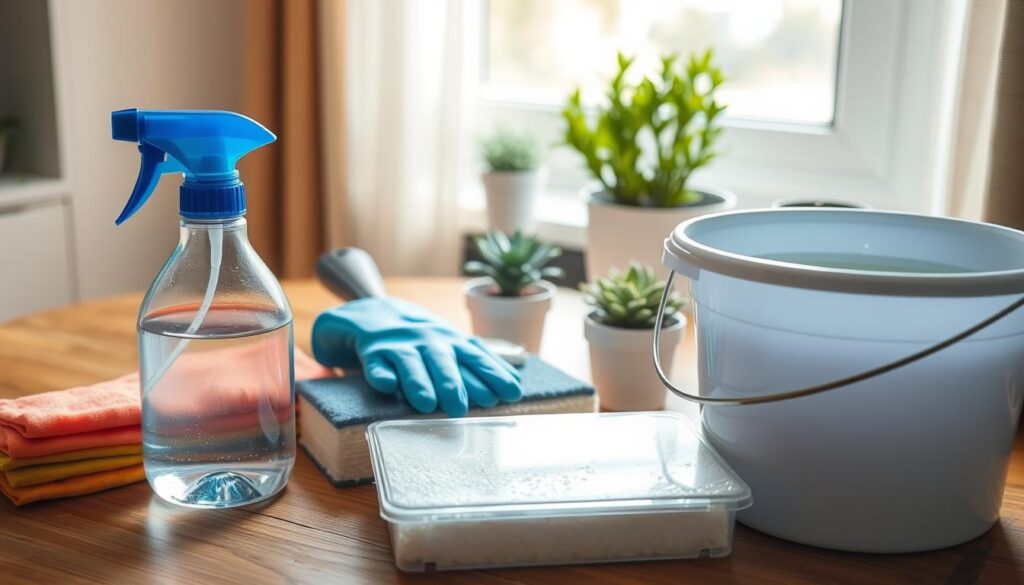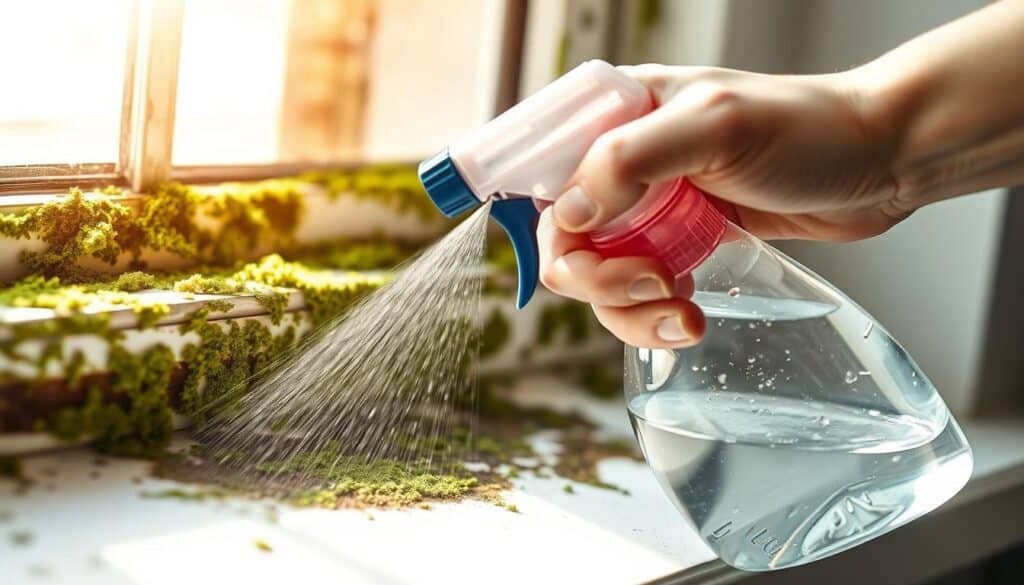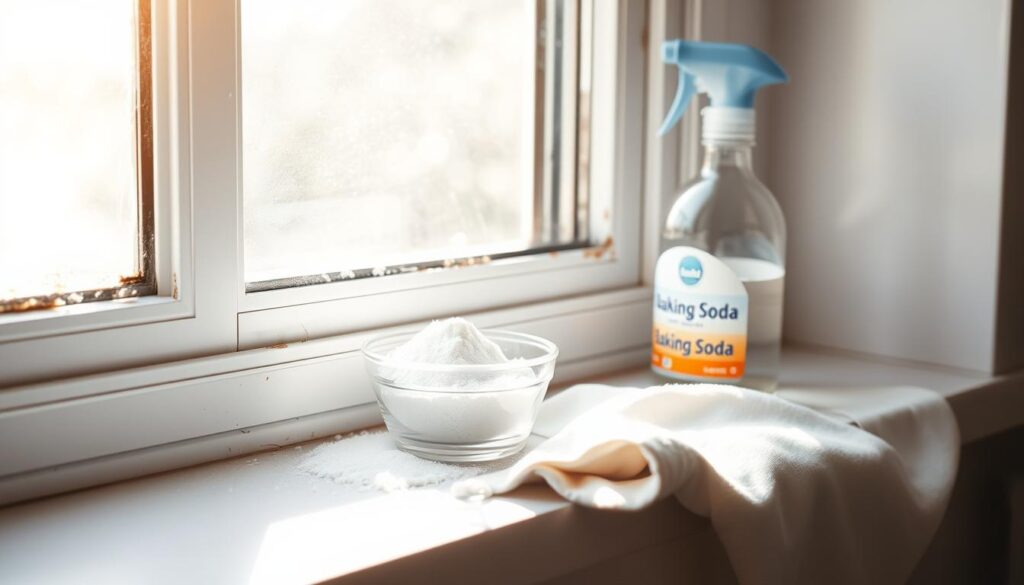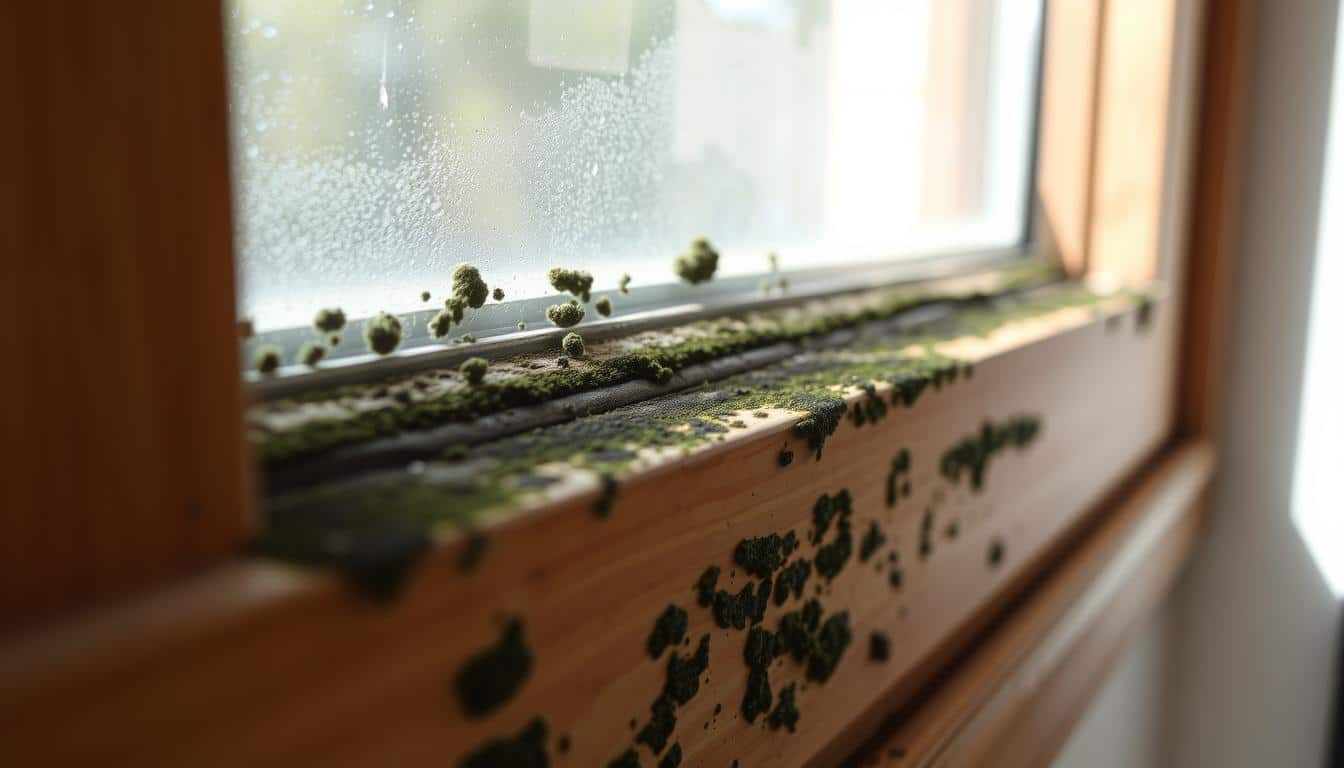Did you know some molds can grow on grout and other non-living things? If you’ve seen mold on your window sills, you’re not alone. Many homes face this issue because of damp conditions. But, you can get rid of mold and keep your home clean.
In this guide, I’ll show you a simple, two-step method to remove mold from window sills. You’ll learn how to keep it from coming back. Say goodbye to those green and black spots for good!
Key Takeaways
- Mold on window sills is a common problem caused by moisture, condensation, and poor ventilation.
- Vinegar, hydrogen peroxide, and baking soda are effective natural solutions for removing mold.
- Proper safety precautions, like wearing a mask and gloves, are crucial when handling mold.
- Regular cleaning and maintaining a moisture-free environment can help prevent future mold growth.
- Professional mold remediation services may be necessary for severe or widespread mold issues.
Introduction: The Unsettling Sight of Mold on Window Sills
Mold loves moist places, and homes often get too wet. This can happen from leaky pipes, floods, or too much humidity. Window sills are a common spot for mold because of the moisture that builds up there.
This problem can harm your health and damage your home. It’s not just a cosmetic issue.
Understanding the Causes and Consequences of Mold Growth
Mold can make people with allergies, asthma, or weak immune systems sick. It can cause breathing problems and other health issues. The mold on your windows is just the beginning. It can spread to places you can’t see, like behind walls or in ducts.
Roof leaks and attic moisture are often missed for a long time. This lets mold do a lot of damage before anyone notices.
Window sills are often ignored because they get dirty and dusty. This makes them a perfect place for mold to grow. Even a little bit of water can start mold growth. So, it’s important to fix leaks and spills fast.
Keeping your home’s humidity below sixty percent can also help stop mold.
“Mold typically takes 48-72 hours to begin growing under favorable conditions.”
Mold’s impact on your home and health is real. Knowing why mold grows and how it affects you is the first step to getting rid of it and keeping it away.
Preparing for the Mold Removal Process
Removing mold from your window sills doesn’t need a lot of tools. But, getting ready in advance makes the job easier and faster. You’ll need the right protective equipment and cleaning solutions. A bit of preparation ensures a successful mold removal.
Essential Gear and Supplies
Before starting, make sure you have these items:
- Rubber gloves to protect your hands
- A high-quality face mask or respirator to filter out mold spores
- Goggles to shield your eyes
- Disposable cloths or rags for cleaning
- Undiluted white vinegar or hydrogen peroxide for disinfecting
- Baking soda for scrubbing
- A sturdy scrub brush or sponge
After cleaning, throw away any moldy materials in a sealed bag. This stops mold spores from spreading.
Safety Precautions for Handling Mold
Mold can be dangerous, especially for people with breathing problems or weak immune systems. It’s important to wear the right safety precautions to keep yourself and your family safe:
- Always wear the right personal protective equipment (PPE).
- Don’t disturb the mold to avoid releasing spores into the air.
- Make sure the area is well-ventilated while cleaning.
- Dispose of moldy materials in a sealed bag or container.
- If the mold is big or you’re worried about your health, consider getting a professional.
By following these steps, you can safely remove mold from your window sills. This keeps your home healthier.

| Necessary Tools for Window Mold Removal | Protective Equipment for Mold Cleaning | Safe Handling of Moldy Materials |
|---|---|---|
|
|
|
“When dealing with mold, it’s crucial to take the necessary safety precautions to protect yourself and your family.”
Step-by-Step Guide: Removing Mold from Window Sills
Removing mold from window sills might seem hard, but it’s doable with the right steps. Start by cleaning the surface well to cut down mold spores. Then, use natural solutions for a deep clean.
Initial Surface Cleaning to Reduce Mold Spores
First, open the window for good air flow. Then, dampen the moldy area with water to stop spores from flying around. Use a dry, disposable microfiber cloth to wipe away mold. This first step helps keep mold spores from spreading.
Deep Cleaning with Natural Solutions
For a deep clean, try using vinegar or hydrogen peroxide. These natural cleaners are strong but gentle, making them perfect for removing mold from windows.
- Mix equal parts white vinegar and water in a spray bottle.
- Spray the moldy areas well, letting it sit for at least an hour to kill the mold.
- Scrub the area with a soft-bristled toothbrush to get rid of any leftover mold.
- Wipe it clean with a microfiber cloth, making sure it’s dry.
By following this guide, you can remove mold from your windows effectively. Remember, fixing the moisture problem is key to stopping mold from coming back.
The Vinegar Method: A Natural and Effective Approach
Vinegar is a great way to get rid of mold on window sills. It’s a mild acid that can kill up to 82% of mold species. This makes it a strong tool against mold, which is harmful and ugly.
To use vinegar, just pour it straight from the bottle onto the moldy areas. Let it sit for about 60 minutes. This lets it work its way into the mold and kill it. Then, clean the area with warm water and a cloth you can throw away.
For even better results, spray the vinegar again and let it dry. This makes sure all the mold is gone. Vinegar works well on porous surfaces, unlike bleach which is better for non-porous ones.
Vinegar is thought to kill 82% of species of mold, leaving a possibility of 18% of persistent species,” explains Jonathan Tavarez, a mold removal expert.
When using vinegar, make sure to be safe. Wear gloves to protect your skin. You can also mix vinegar with other mold fighters like borax or baking soda to make it stronger.

Choosing vinegar to fight mold is a smart move. It’s natural and doesn’t harm you or the environment. It gets rid of mold and keeps it from coming back, making your home healthier and more eco-friendly.
Hydrogen Peroxide: An Alternative to Bleach
Don’t like using harsh chemicals like bleach? Hydrogen peroxide is a natural alternative for mold on window sills. It’s a strong disinfectant that kills bacteria, viruses, fungi, and mold spores. Studies show it’s as good as bleach at stopping mold growth on surfaces.
To remove mold with hydrogen peroxide, fill a spray bottle with a 3% solution. For glass, mix it with hot water and spray on the mold. Let it sit for 15 minutes. Then, rinse and wipe clean with a cloth.
But, hydrogen peroxide might not work as well on porous surfaces like wood or fabrics. For these, try vinegar or baking soda. Yet, it’s great for window sills, offering a safe and effective way to remove mold and prevent future growth.
“Hydrogen peroxide is a versatile and effective tool for tackling mold on a variety of surfaces, making it a great alternative to harsh chemicals like bleach.”
Next time you see mold on your window sills, grab hydrogen peroxide. It’s a safe, natural, and efficient way to keep your home mold-free and windows clean.
Baking Soda: A Gentle Abrasive for Stubborn Mold
Baking soda is a great tool for removing stubborn mold from window sills. It works as a gentle scrub, removing even the toughest mold. By making a simple baking soda solution, you can clean your window sills effectively.
Creating a Baking Soda Solution for Scrubbing
To make a mold-removing solution, mix one teaspoon of baking soda with two cups of water. Pour it into a spray bottle, shake well, and you’re set to scrub.
Spray the solution on your window sills, covering the whole area. Use a scrub brush or scouring pad to remove the mold. The baking soda’s gentle scrubbing action will leave your sills clean and fresh.
After scrubbing, clean the area with a damp cloth or paper towel. Spray the solution again and let it air-dry. This step ensures all mold spores are gone, stopping future growth.

“Baking soda is a powerful yet gentle cleaning agent that can effectively remove even the most stubborn mold from window sills. Its abrasive properties make it an ideal choice for tackling tough mold problems.”
Using baking soda is a safe and effective way to remove mold from window sills. It’s a natural method that keeps your home healthy and mold-free.
How to Get Rid of Mold on the Window Sill
Mold on window sills is a common problem. It can harm your indoor air quality and health. But, there are ways to remove mold and stop it from coming back. Here’s a detailed window mold cleanup guide to help you keep your home healthy and mold-free.
To get rid of mold on a window sill, you can use undiluted white vinegar or a bleach solution. Vinegar is a gentler option. If vinegar doesn’t work, try bleach. Bleach can kill mold, but the EPA warns against using it too often.
- Start by cleaning the window sill with a vinegar and water mix. Use a stiff-bristled brush to scrub off any mold.
- If vinegar doesn’t work, mix bleach with water. Use one part bleach to three parts water. Apply it, wait 10-15 minutes, then scrub.
- Finally, rinse the area with clean water and dry it well to stop mold from coming back.
Good ventilation and controlling moisture are crucial to stop mold on window sills. Check your windows for leaks or condensation often. Fix any issues quickly. By following these effective methods for removing mold from window sills, you can keep your home clean and healthy.
“Mold spores release toxins, known as mycotoxins, which when breathed in can cause damage to lungs, skin, and the nervous system.”
Preventing Future Mold Growth on Window Sills
To keep your window sills mold-free, you need to act early. Simple steps can stop mold from coming back. It’s all about managing moisture, ensuring good air flow, and keeping up with cleaning.
Maintaining Proper Ventilation and Moisture Control
Mold loves damp, humid places. So, it’s key to control moisture. Watch for window condensation and clean it off right away. Use fans or dehumidifiers to keep humidity in check.
Also, make sure your bathroom and kitchen vents work well. Check your windows for leaks or cracks that let moisture in.
Regular Cleaning and Maintenance Routines
Cleaning your window sills regularly is important. Try to do it every 1-2 months. Use a mix of vinegar and baking soda or a mild soap.
Also, check the caulking around your windows often. Fix any gaps or cracks to stop moisture from getting in. And, make sure the window tracks are clean. Debris there can cause mold.
By doing these things, you can prevent mold on windows. You’ll also keep your window sills dry and stop window mold from coming back.
“Proper ventilation, humidity control, and cleanliness are essential to prevent mold reoccurrence.”
The Role of Microfiber in Mold Removal
Removing mold from window sills can be a tough task. But, using the right tools makes it easier. Microfiber is a top pick for this job. Its special features make it a key player in fighting mold spores.
Understanding Microfiber’s Efficiency in Capturing Mold Spores
Mold spores are tiny, smaller than a human hair. Microfiber, with its fine fibers, is perfect for catching these spores. This means it can capture mold spores during cleaning, stopping them from spreading.
Unlike cotton rags or paper towels, microfiber cloths are better at trapping mold spores. Using microfiber cloths for window mold cleanup ensures you remove mold and its spores, not just move them around.
| Material | Diameter | Mold Spore Capture Efficiency |
|---|---|---|
| Human Hair | 100 microns | Low |
| Microfiber | 1 micron | High |
| Mold Spores | 3-40 microns | N/A |
Knowing the size difference between microfiber and mold spores shows why microfiber cloths for mold spore removal are best. This knowledge helps you tackle mold on window sills effectively. It lets you take back a clean, healthy home.
When to Seek Professional Mold Remediation Services
DIY methods can handle small mold growth on window sills. But, for bigger mold problems, you should call the pros. This is to keep your home and family safe.
Mold on windowsills might mean a bigger issue. Seeing mold on walls, floors, or woodwork is a warning sign. Mold can spread fast, harm air quality, and damage your home if not treated.
- When the mold growth covers an area larger than 10 square feet, it’s time to call in the experts.
- If you suspect the presence of toxic black mold, which can produce harmful mycotoxins, professional remediation is essential.
- If you or your family members experience persistent respiratory issues, skin irritations, or other health problems that may be linked to mold exposure, it’s prudent to have a professional assessment.
Mold remediation experts have the right tools and know-how. They can find the mold’s source, seal off the area, and remove it safely. They also test air quality and fix any damage.
Don’t wait to get help for big mold problems. Your family’s health and your home’s safety are worth it. Get professional mold remediation services.
Conclusion: Embracing a Mold-Free Living Environment
After learning how to remove mold from window sills, I’m ready to make my home healthier. I will tackle mold’s causes, use the right cleaning, and maintain regularly. This way, I can keep my home, including window sills, mold-free.
It’s important to check for water leaks and dampness often. Mold can hide in many places, not just bathrooms and basements. Keeping humidity low and fixing leaks quickly helps prevent mold.
Following advice from the National Institute of Environmental Health Sciences helps me keep my home mold-free. I’ll ensure good ventilation, use mold-resistant materials, and apply mold inhibitors where needed. With these steps, my home will stay safe and healthy for my family.
FAQ
What are the essential supplies needed to remove mold from window sills?
To remove mold from window sills, you’ll need rubber gloves, a mask, and goggles. Also, get disposable cloths, undiluted white vinegar or hydrogen peroxide, baking soda, and a scrubber.
How does moisture and condensation contribute to mold growth on window sills?
Moisture, like humidity and condensation, is key to mold growth on window sills. When moisture stays, it creates a perfect spot for mold to grow.
Why is bleach not recommended for removing mold from windows?
Experts say bleach is bad for killing mold because it only works on the surface. It makes mold come back. Vinegar or hydrogen peroxide are better and safer choices.
How can baking soda be used to remove stubborn mold from window sills?
For tough mold, mix baking soda with water to make a paste. Use a scrubber to scrub it off. Baking soda is great for removing mold naturally.
What is the importance of using microfiber cloths when cleaning moldy windows?
Microfiber cloths are good because they’re smaller than mold spores. They can pick up and remove mold well. They’re better than regular cloths for cleaning mold.
When should I consider hiring a professional mold remediation service?
If mold is not just on windows but also in other areas, get a pro. This could mean a bigger mold problem in your home that needs more help.




